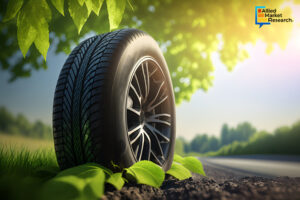Global green tire industry forecast with a CAGR of 8.7 percent through 2031
Pune, India – According to the recent report published by Allied Market Research, the global green tire industry is anticipated to display a noteworthy CAGR of 8.7% from 2022 to 2031. Green tires, modified to integrate silica into their composition, are designed to reduce rolling resistance for an environment-friendly future sustained long-term while enhancing energy efficiency and safety. The addition of silica to tire materials improves performance, reduces greenhouse gas emissions, and promotes sustainable mobility. This contrasts with traditional tire materials such as styrene-butadiene rubbers, semi-aromatic polyamides, and polycyclic aromatic hydrocarbons. The increase in accessibility of automotive sector toward green tires drives the growth of the global green tire industry, supported by strict government regulations and rising consumer awareness of environmental impacts.
The increase in the rolling resistance of vehicles plays a crucial role in emitting carbon. As rolling resistance increases, the energy required to overcome friction also increases, resulting in higher pollutant emissions. This helps to reduce the overall weight of vehicle types, leading to lower fuel consumption. Developing green tires improves gasoline consumption by reducing rolling resistance. Rolling resistance raises the energy required for tires to contact the road surface and deform. To minimize rolling resistance, it necessitates comprehensive control of the composite relationship between tread pattern, tire structure, and rubber compound. Rolling resistance contributes to around 10 to 15% of fuel consumption in passenger cars and is expected to increase to 30% in heavy vehicles. Hence, the increase in demand for enhanced rolling resistance in tires propels the growth of the global green tires industry.
Exploring eco-friendly alternatives such as rubber derived from plants and enhancing the availability of natural rubber are crucial areas of focus. Cooper Tire, in collaboration with partners such as Clemson and Cornell, received a $6.9 million grant for the study of guayule rubber for tire production. Through this research, they successfully designed prototype tires using solely guayule rubber, proving its viability. There is potential for expanding sustainable tire manufacturing by substituting less sustainable materials such as synthetic rubber and carbon black. The goal is to minimize waste, and energy consumption, and ensure eco-friendly disposal practices.
Michelin has recently introduced new tires for cars and buses with a higher proportion of sustainable materials, up to 58% of which are environment friendly. The performance of these tires is comparable to that of traditional ones. By 2050, the company intends to use only sustainable materials in all its tires, with a target of 40% by 2030.
In its products, Michelin uses environmentally friendly materials such as natural rubber, recycled carbon black, and bio-based oils. The company aims to minimize its environmental impact while maintaining a high level of performance across all aspects of its activities, from product design to recycling efforts. With many experts, Michelin strives to lead the way in sustainable tire technologies. It focuses on collaboration with other companies to accelerate progress, particularly regarding recycling tires.
Michelin has advanced towards a circular economy by establishing initiatives such as Pyrowave and Carbios, which involve the conversion of old tires into new materials. Frequently, Michelin demonstrates its commitment to high quality, sustainability, and environmental protection standards through its tire developments.
Key developments in the green tire industry: In March 2020, Goodyear introduced a pioneering concept of self-regenerating tires
Goodyear unveils the innovative ReCharge concept, enhancing tire longevity and adaptability by integrating a self-recharging design. This tire concept incorporates liquid-filled capsules made of organic materials reinforced with spider silk fibers.
In November 2022, GRI proudly launched the Green XLR Earth 65+
During the SIMA 2022 exhibition in Paris, GRI presented its latest agricultural tire called Green XLR EARTH 65+. This tire belongs to the Green XLR Earth Series, designed for sustainability.
Green XLR EARTH 65+ is made with 37.5% sustainable materials. It has a unique tread design that improves the comfort of drivers both on and off the road while improving the steering of tractors at higher speeds. In addition, the tread design improves fuel efficiency, provides better traction for off-road driving, and extends the lifespan of the tire. Green XLR EARTH 65+ has a green color and is made from sustainable materials, such as recycled rubber and natural oils, avoiding harmful chemicals.
The global green tire industry is driven by innovative technologies and environment-friendly materials such as silica and bio-based rubber. Leading companies such as Michelin and Goodyear have focused on research and development to achieve a circular economy while reducing rolling resistance, emissions, and environmental impacts, ensuring a greener future for all.
The global green tire industry thrives on eco-friendly innovations, such as silica integration and bio-based rubber, which reduce emissions and promote sustainability. The top players, including Michelin and Goodyear, are champions of circular economy initiatives and have developed high-performance tires with a reduced environmental footprint for a green future.

